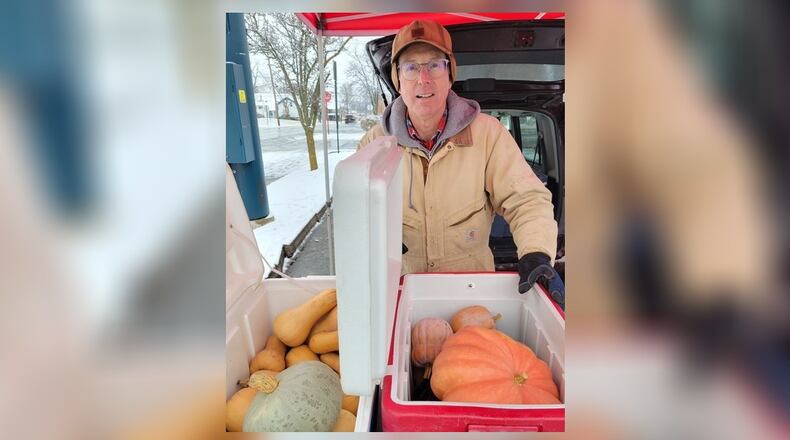Squash has been cultivated for more than 10,000 years ago in Central America, possibly the oldest plant cultivated for food in the Western Hemisphere. Winter squash, like summer squash, is actually grown in the summer, but gets its name because most varieties can be stored through the winter thanks to its thick rind.
The English word “squash” derives from the Narragansett word askutasquash, which means “a green thing eaten raw,” presumably summer squash. “Squash” as a verb, meaning to crush, as well as the racquet sport, derives from Romance languages and has no connection with the etymology of the food.
The display of Stoney Hedgerow winter squash at MOON Co-op is a visual delight, an artistic wonder. I count more than a dozen varieties, in many shapes, ranging in size from tiny to over 5 pounds, a riot of colors including bright orange, blue, green, pink, tan, and striped.
MOON Co-op’s display of Stoney Hedgerow winter squash includes the familiar acorn and butternut squash, but unfamiliar varieties dominate the display. Even the names are exotic: autumn frost (tawny-colored and “better than butternut”), blue kuri (gets moister with age), blue prince (deep orange flesh), Cinderella’s carriage (huge and looks like its name), red kuri (edible orange skin), starry night (similar to acorn), sunshine kabocha (orange, sweet and nutty), tetsukabuto (dark green custard-like), Thelma Sanders (yellow heirloom, like sweet potato), and yuxi jiang bing gua (bright green Chinese heirloom).
You have five basic choices to handle any winter squash: roast for a side dish, stuff for a main dish, steam for a soup, bake for a sweet dessert, or shred for a salad.
The first step is cutting open the squash to remove the seeds. Chop a large squash into several pieces.
If you can’t get a knife through the raw squash, don’t hurt yourself. Microwave the whole squash for a few minutes, then cut it open and chop into pieces if necessary.
Baking squash pieces takes around 30 minutes in a 400 oven. Rub the squash pieces first with either olive oil, butter, orange juice, or soy sauce.
The average American eats only around 1.5 pounds of squash per year. I wrote back in October that Libby’s canned “pumpkin” is actually a variety of squash, so that’s possibly the only way that many Americans consume winter squash.
Oregon State University agronomists have created a website called Eat Winter Squash. They were shocked to find that winter squash in their local supermarkets had been imported from California and Mexico. Their motto is “put the winter back in winter squash.” I second the motion.
Local winter squash is available at MOON Co-op, Oxford’s consumer-owned full-service grocery, featuring natural, local, organic, sustainable, and Earth-friendly products. The store, located at 516 S. Locust St. in Oxford, is open to the public every day. Visit it online at mooncoop.coop.
About the Author
